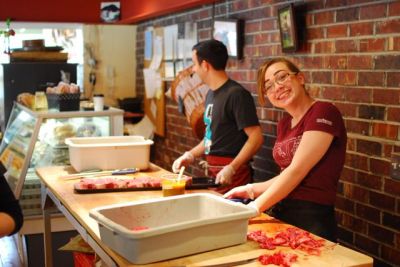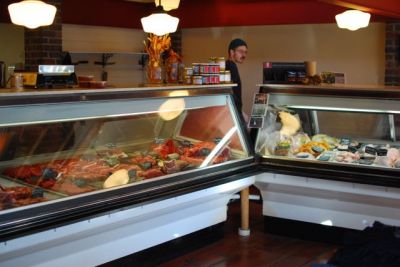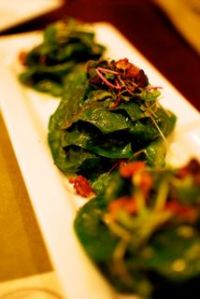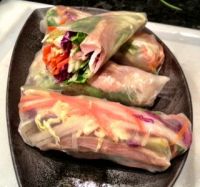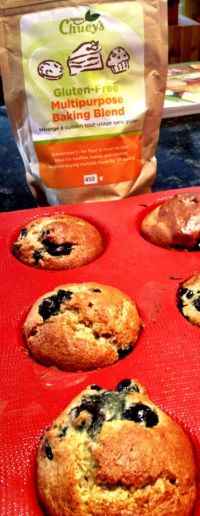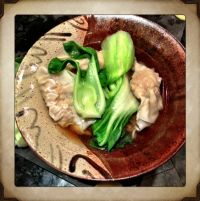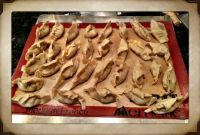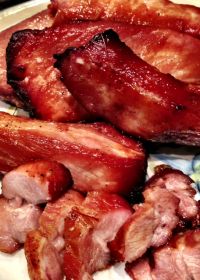*update* My full 13-minute conversation with Top Chef Canada contestant Dan Hudson of Hudson’s on First in Duncan is now available for your listening pleasure. Click here to listen to the mp3 version.
The third season of Top Chef Canada begins next Monday night, and it will feature, for an unknown number of weeks, a chef from the Cowichan Valley. I profiled the chef on this week’s edition of Food Matters on All Points West.
I love Top Chef Canada, but keep in mind that this is reality-based TV, so the production company records an awful lot of video and can then manipulate the video to create story lines and build, or destroy, the characters of the participants, which is probably why most people like to watch it. Now, I like to see some drama in the kitchen as much as anyone. But, I’m not much of a fan of other reality-based TV shows. What I really like about this one is that to a large extent you really have to know how to cook to win the title. I watched Gordon Ramsay’s Hell’s Kitchen for one season and if I were a restaurant owner I really wouldn’t have wanted any of those so-called chefs running my kitchen. But the chefs on Top Chef Canada actually have decent credentials and they really have to cook at the top of their game to win.
 Courtesy Food Network Canada
Courtesy Food Network Canada
Representing the hopes of Vancouver Island this year is Dan Hudson. (I think on the show they are calling him ‘Daniel’.) His restaurant is Hudson’s on First, on First Street in downtown Duncan. It just opened last November, but I’ve known Dan for a few years. He’s 30 years old, from England, but he came to Canada to work in some top kitchens here. His wife is from the Cowichan Valley, so he moved to Duncan a few years ago and worked in various locations while they were planning to open their own restaurant. Dan anchors the kitchen while his wife Andrea runs the front of house. While many of us looking forward to the restaurant opening were reading Facebook updates about renovations, Dan was secretly off in Toronto filming Season 3 at the end of August. He had been all set to appear in Season 2 but just as filming was to start his mother passed away and he had to go back to England. But when Season 3 casting started, he entered again, with some help from his old boss, Dale McKay, who had won Top Chef Canada Season 1:
“I spoke with him and I think he put a good word in for me with the producers, and we talked quite a bit about what happens on the show, but even with hearing all of that it doesn’t compare to what actually happens.”

Chef Daniel -rare day off
A lot of the advantages you get when it comes to being judged on Top Chef have to do with thinking on your feet. Dan says this was the hardest part, despite having worked in restaurants since his late teens:
“Working in a professional kitchen is strenuous at the best of times, but it is nothing like what you have to do in the TV show. They tell you what you have to do, and then…go. You have only a couple of minutes to figure out what you are going to do and then you just have to go with your gut and do it. There’s no time to second guess yourself, and even if you went there with some dishes in mind that you’d like to cook, that all goes out the window and it’s definitely a bit of a scramble at times, yeah.”
The chefs are contractually obligated to not say anything that will give away any of the results of the show before it airs, but he was able to give me a bit of insight into the whole experience, especially when I asked him about Chef Mark McEwan. He owns an empire of restaurants and specialty shops in Toronto, and he is also the head judge on Top Chef Canada. I interviewed him a few years ago when the show was first airing, and he told me he didn’t care which chefs had the most endearing personality, or looked good, he wanted them to be able to cook. And he comes across as someone who doesn’t suffer fools gladly, so I asked Dan what it was like to be under his scrutiny:
“He doesn’t mess around…he doesn’t care if you are the most charismatic person around, if you are not cooking properly he will let you know. During the recording, a lot of chefs got sick, we were all living in the same house, but that didn’t matter to him. You had to work through it, he said it was just as if you came to work with a hangover, you just have to keep going, yeah, he was a badass, yeah.”
British Columbia is well-represented in Top Chef Canada Season 3. Clement Chan is from the Fairmont Pacific Rim Hotel in Vancouver and also runs a food truck on the side, Kayla Dhaliwal is originally from Victoria, but is now working in Steveston, Nicole Gomes is from Richmond, and now works in Calgary, Caitlin Hall is from Maple Ridge and is now the chef de cuisine at Pied-à-Terre restaurant in Vancouver. And Matthew Stowe grew up in Surrey and is now a product development chef for the Cactus Club Café chain. They are all quite young, but they also all have some impressive education and experience to their credit, so I’m really looking forward to see how they do.
One thing I worry about: They always have a guest line-up of celebrity judges to test the mettle of the contestants, and while the first season judges were mostly chefs and restaurateurs, this year they are really getting into people who don’t have a restaurant background, like professional wrestler Trish Stratus, comedian Russell Peters and the Real Housewives of Vancouver. To me that kind of takes away some of the credibility of the competition, but I mentioned that to Dan and he said, ‘you have to serve them and work just as hard to please them as you would any judge and anyone who walks into your restaurant.’
So there you go…I wish I could tell you more, but certainly Dan couldn’t tell me any more so we will just have to watch. The show premieres next Monday night at 6pm Pacific on Food Network Canada. If you don’t have it on cable you can watch full episodes on the Food Network website within the next day or two after each episode.
You can also hear this column as it aired on All Points West when it is posted on this CBC Radio webpage.






